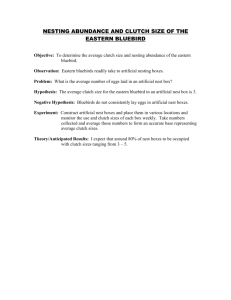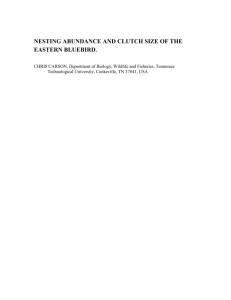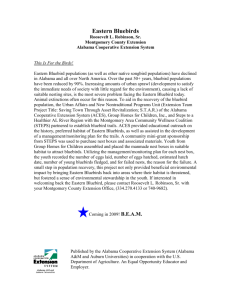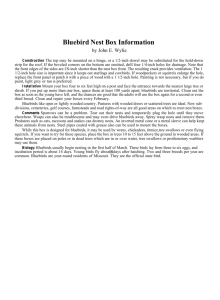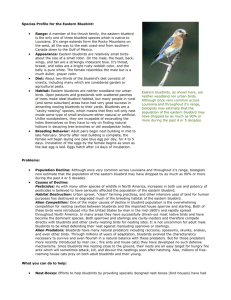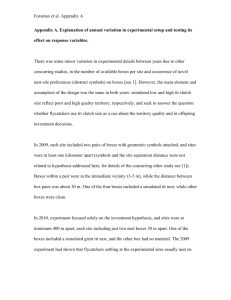Manuscript
advertisement
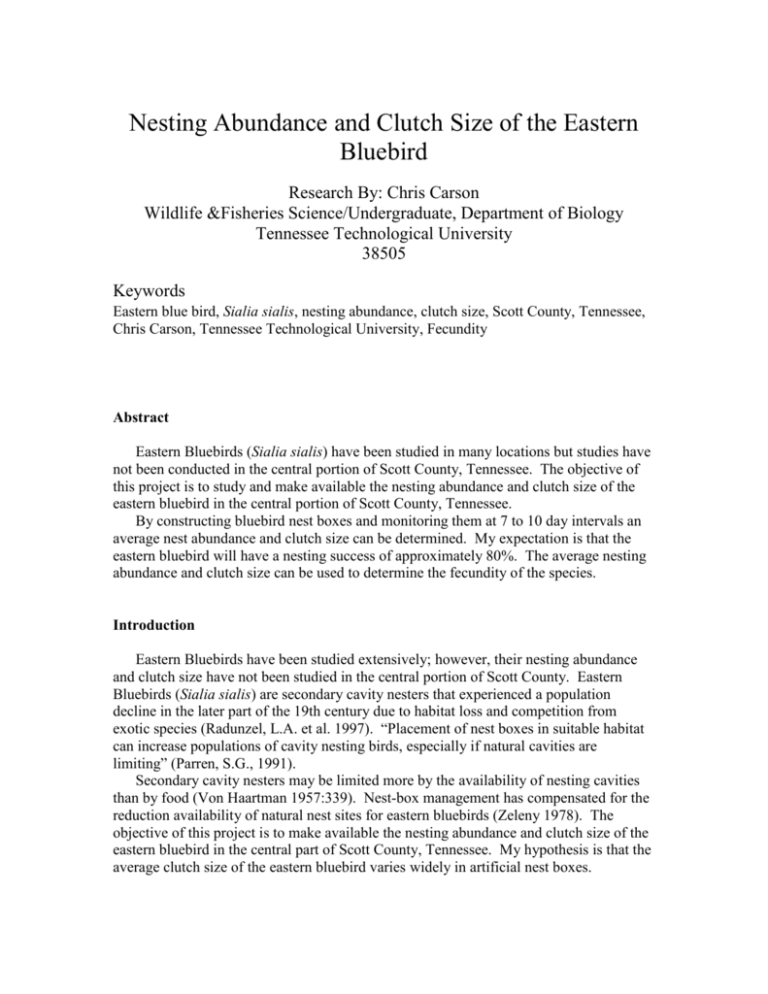
Nesting Abundance and Clutch Size of the Eastern Bluebird Research By: Chris Carson Wildlife &Fisheries Science/Undergraduate, Department of Biology Tennessee Technological University 38505 Keywords Eastern blue bird, Sialia sialis, nesting abundance, clutch size, Scott County, Tennessee, Chris Carson, Tennessee Technological University, Fecundity Abstract Eastern Bluebirds (Sialia sialis) have been studied in many locations but studies have not been conducted in the central portion of Scott County, Tennessee. The objective of this project is to study and make available the nesting abundance and clutch size of the eastern bluebird in the central portion of Scott County, Tennessee. By constructing bluebird nest boxes and monitoring them at 7 to 10 day intervals an average nest abundance and clutch size can be determined. My expectation is that the eastern bluebird will have a nesting success of approximately 80%. The average nesting abundance and clutch size can be used to determine the fecundity of the species. Introduction Eastern Bluebirds have been studied extensively; however, their nesting abundance and clutch size have not been studied in the central portion of Scott County. Eastern Bluebirds (Sialia sialis) are secondary cavity nesters that experienced a population decline in the later part of the 19th century due to habitat loss and competition from exotic species (Radunzel, L.A. et al. 1997). “Placement of nest boxes in suitable habitat can increase populations of cavity nesting birds, especially if natural cavities are limiting” (Parren, S.G., 1991). Secondary cavity nesters may be limited more by the availability of nesting cavities than by food (Von Haartman 1957:339). Nest-box management has compensated for the reduction availability of natural nest sites for eastern bluebirds (Zeleny 1978). The objective of this project is to make available the nesting abundance and clutch size of the eastern bluebird in the central part of Scott County, Tennessee. My hypothesis is that the average clutch size of the eastern bluebird varies widely in artificial nest boxes. Methods and Materials Artificial nest boxes were constructed from 2.54cm x 15.24 x 304.8cm boards. Nest boxes were constructed using plans provided in the Tennessee Wildlife Resources publication Wildlife Management for Tennessee Landowners. All nest boxes will be placed at a height of 1.50 meters and a minimum distance of 100 meters from other boxes. The boxes will be spread out over a 404.68 hectare family farm in Scott County, Tennessee. All boxes were placed with the entrance hole facing nearby woody debris or trees. The boxes were monitored for activity at 7 to 10 day intervals (Radunzel, L.A. et al. 1997), using a data form (figure 2.1). An average of nest box activity and clutch size was conducted to determine the clutch size and nesting success for bluebirds in the central part of Scott County, TN. Results & Discussion I found that eastern bluebirds nest readily in artificial nest boxes. Boxes were placed in open habitat preferred by eastern bluebirds (Prescott, 1982). Exactly 9 of 10 boxes paced on a 404.68 hectare study area were found to be occupied. The average nesting abundance and clutch size can be used to determine the fecundity of the species in the central part of Scott County, Tennessee. Clutch size is defined by Radunzel, L.A. et al. 1997 as the number of eggs observed in each nest. Other studies have shown that the average clutch size of eastern bluebirds varies based on location (Dhondt, 2000). These variations are shown in figure 3. The average number of eggs present in nest boxes was found to be 3.3 (figure 1, table 1). These numbers were slightly lower than normal numbers for early season nests but may be a result of normal annual variation in bluebirds (Lumsden, 1986). Conclusion Based on the data I collected during my study in the central portion of Scott County, Tennessee I have concluded that the eastern bluebird has a mean clutch size of 3.3 and a average hatch rate of 3 young. Based upon this data I conclude that the species is considered stable at this time. However, further long term monitoring is needed to make a definite conclusion about the fecundity of the species. -2- Literature Cited Dhondt, A. A. , Kast, T. L. and Allen, P. E. 2000. Clutch-size Variation in Bluebirds. Birdscope, Volume 14, Number 2: 3-5. Eastern Lumsden, H.G. 1986. Choice of nest boxes by eastern bluebirds. Can. Field-Nat. 100:343 -349. Parren, S.G., Wildlife Society Bulletin. 1991. Evaluation of Nest-Box Sites Selected by Eastern Bluebirds, Tree Swallows, and House Wrens. 19 : 270-277. Prescott, H.W. 1982. Using paired nesting boxes to reduce swallow-bluebird competition. Sialia 4:3-7. Pitts, D.T.,1988. Journal of Field Ornithology. Effects of Nest Box Size on Eastern Bluebird Nests. 59-4: 309-313. Radunzel, L. A. and Muschitz, D.M. 1997. Journal of Field Ornithology. A Long-Term Study of the Breeding Success of Eastern Bluebirds by Year and Cavity Type. 68:7-18. Von Hartman, L. 1957. Adaptations in hole-nesting birds. Evolution 11:339-347. Zeleny, L. 1978. Nesting box programs for bluebirds and other passerines. Pages 5560. -3- Appendix A Location: Time: Temperature: Box Number Date: Observer: box occupied? eggs present? number of Eggs habitat # of eggs hatched Figure 2.1 -4- Appendix B 6 5 4 Number 3 Clutch Size 2 Hatched 1 0 1 2 3 4 5 6 7 8 9 10 Box Number Figure 2 Figure 1 Box # Clutch Size Hatched 1 2 2 2 4 4 3 3 3 4 0 0 5 4 3 6 2 2 7 6 4 8 3 3 9 5 5 10 4 4 Table 1 -5- Average 3.3 3
